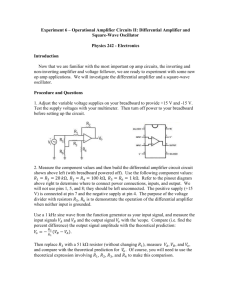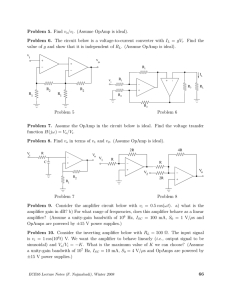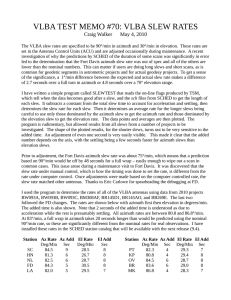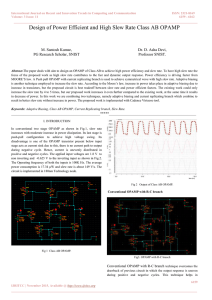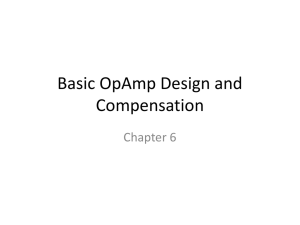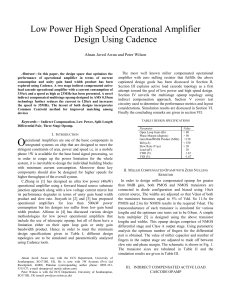The Filter Wizard issue 5: Use it or Slew it Kendall Castor
advertisement
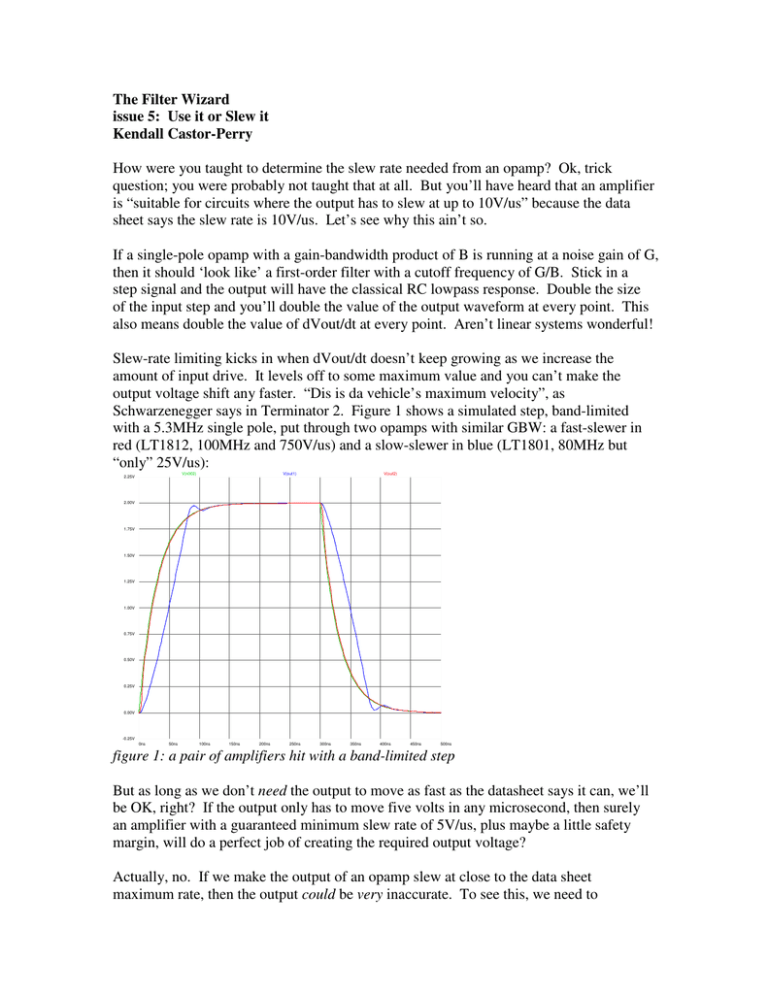
The Filter Wizard issue 5: Use it or Slew it Kendall Castor-Perry How were you taught to determine the slew rate needed from an opamp? Ok, trick question; you were probably not taught that at all. But you’ll have heard that an amplifier is “suitable for circuits where the output has to slew at up to 10V/us” because the data sheet says the slew rate is 10V/us. Let’s see why this ain’t so. If a single-pole opamp with a gain-bandwidth product of B is running at a noise gain of G, then it should ‘look like’ a first-order filter with a cutoff frequency of G/B. Stick in a step signal and the output will have the classical RC lowpass response. Double the size of the input step and you’ll double the value of the output waveform at every point. This also means double the value of dVout/dt at every point. Aren’t linear systems wonderful! Slew-rate limiting kicks in when dVout/dt doesn’t keep growing as we increase the amount of input drive. It levels off to some maximum value and you can’t make the output voltage shift any faster. “Dis is da vehicle’s maximum velocity”, as Schwarzenegger says in Terminator 2. Figure 1 shows a simulated step, band-limited with a 5.3MHz single pole, put through two opamps with similar GBW: a fast-slewer in red (LT1812, 100MHz and 750V/us) and a slow-slewer in blue (LT1801, 80MHz but “only” 25V/us): V(n002) 2.25V V(out1) V(out2) 2.00V 1.75V 1.50V 1.25V 1.00V 0.75V 0.50V 0.25V 0.00V -0.25V 0ns 50ns 100ns 150ns 200ns 250ns 300ns 350ns 400ns 450ns 500ns figure 1: a pair of amplifiers hit with a band-limited step But as long as we don’t need the output to move as fast as the datasheet says it can, we’ll be OK, right? If the output only has to move five volts in any microsecond, then surely an amplifier with a guaranteed minimum slew rate of 5V/us, plus maybe a little safety margin, will do a perfect job of creating the required output voltage? Actually, no. If we make the output of an opamp slew at close to the data sheet maximum rate, then the output could be very inaccurate. To see this, we need to understand why an opamp with the usual slew-limiting mechanism is not just an ideal opamp with an added “if-then” qualification that just stops the output from ‘moving too fast’. For a good description of “where slew rate comes from”, you can’t go wrong with AoE, pp407-408 in the 2nd edition (come on, Win and Paul, we’ve been waiting soooo long for that 3rd edition). But you must read between the lines. In the classic opamp, the rate of change of output voltage is limited by how much current the input stage can dump into the compensation capacitor. This input stage is commonly a differential pair; two devices sharing a common ‘tail’ current source so that the sum of the two device currents is constant. Finite voltage between the inputs drives the diff pair to ‘steer’ its precious current into, or out of, the compensation capacitor. Here’s a picture of that classical architecture: figure 2: inside an op-amp, from http://archive.chipcenter.com/analog/c014.htm “Are Op-Amps Really Linear” by Barrie Gilbert This steering process has two features. First, and most obviously, it has limits – you can’t steer more than 100% of the tail current into the capacitor. You can huff and puff, supply extra input voltage, but no more current can flow. The output voltage is slewing as fast as it can; it’s completely unresponsive to further changes in the input voltage, so the incremental gain of the amplifier has dropped to zero – nothing, nada. This may not be obvious to the casual scope-prober, since the output voltage is still thundering around in the direction determined by the input signal. But if you add a little extra signal – a small squeak from a strut that’s about to snap, a sneaky little kiss of the high-hat – it’s won’t appear at the output. What’s more, there’s no forward gain in the loop; while the feedback cat is away, the open-loop error mice do play. So don’t expect the ‘normal’ level of power supply rejection (my favourite), or any suppression of internally-generated noise. And don’t expect your average opamp model to show this in simulation, neither! There’s a more subtle consequence that caught me out many years ago in a filter design. If the input stage of the amplifier is made with bipolar transistors untouched by emitter degeneration (to achieve low input noise), the relationship between the pair’s output current change and input voltage is far from linear. The open-loop gain of the amplifier is proportional to the slope of the input characteristic. As soon as you push the input stage away from balance, this slope starts to fall. You can show (yes, you – it’s homework time, see http://www.rfdesignline.com/howto/208200124 and http://www.rfdesignline.com/howto/208200364 for hints) that as the input stage modulation index increases with the input drive, the gain of this pair – and hence the gain and the gain-bandwidth of the whole amplifier – falls. For circuits whose performance is sensitive to the GBW of the amplifier – including many active filters – this causes significant errors. In my case, unacceptable peaking of the filter response near the cutoff frequency, but only on large input signals. Here’s a table showing how the gain factor falls with increasing drive. The open loop gain falls by 10% when the output is only slewing at 32% of its maximum rate. X [ = (I2-I1)/It] 0 0.1 0.316 0.5 0.762 1 V/2Vth 0 0.10034 0.3274 0.5493 1 infinite I1/It 0.5 0.45 0.342 0.25 0.119 0 I2/It 0.5 0.55 0.658 0.75 0.881 1 gain factor 1 0.99 0.9 0.75 0.42 0 The moral is that you sometimes need to specify a slew rate that’s much higher than the signal needs to move at. When someone says: “this amplifier has a unity gain bandwidth of 5MHz and a slew rate of 10V/us”, you must say “yes, but probably not at the same time”. Has this ever caused you a slew of problems? – Kendall


